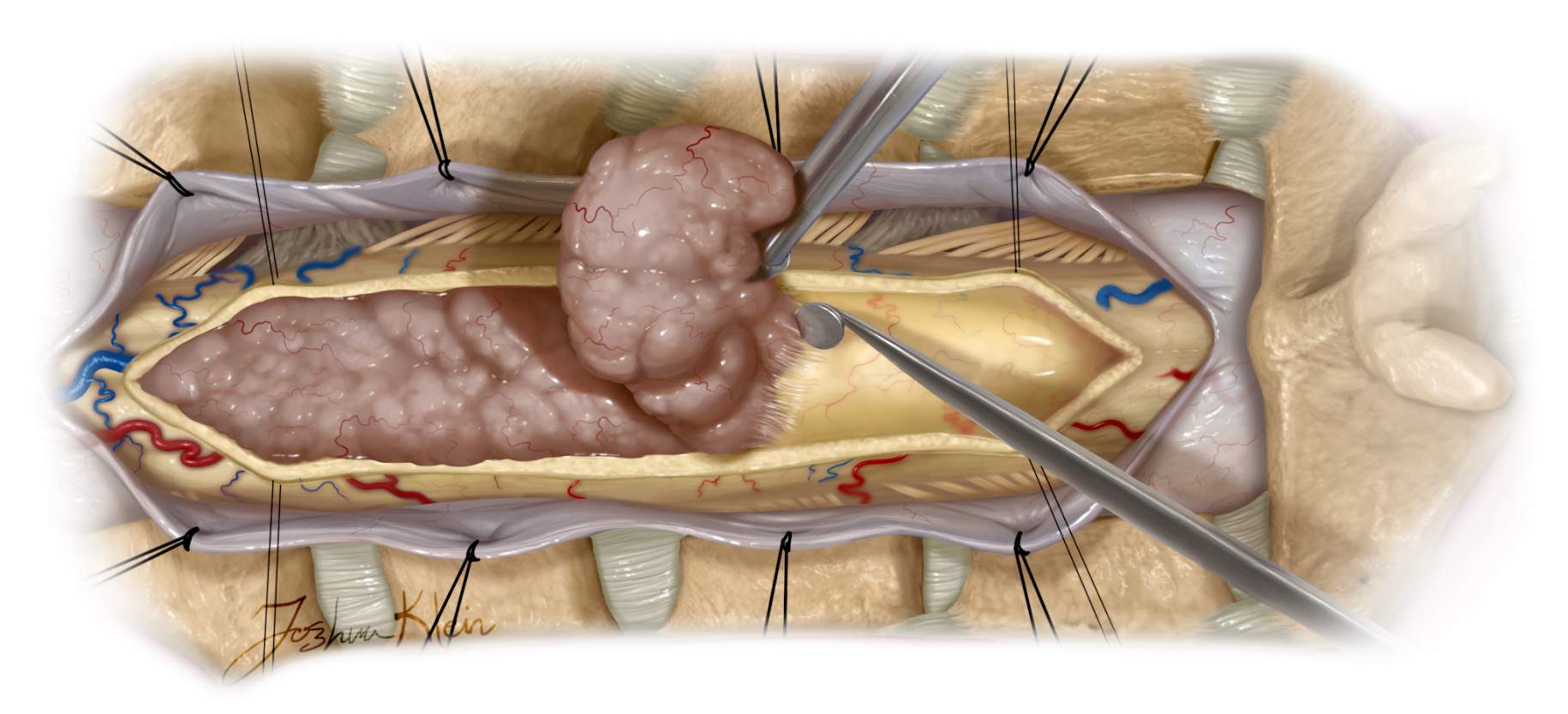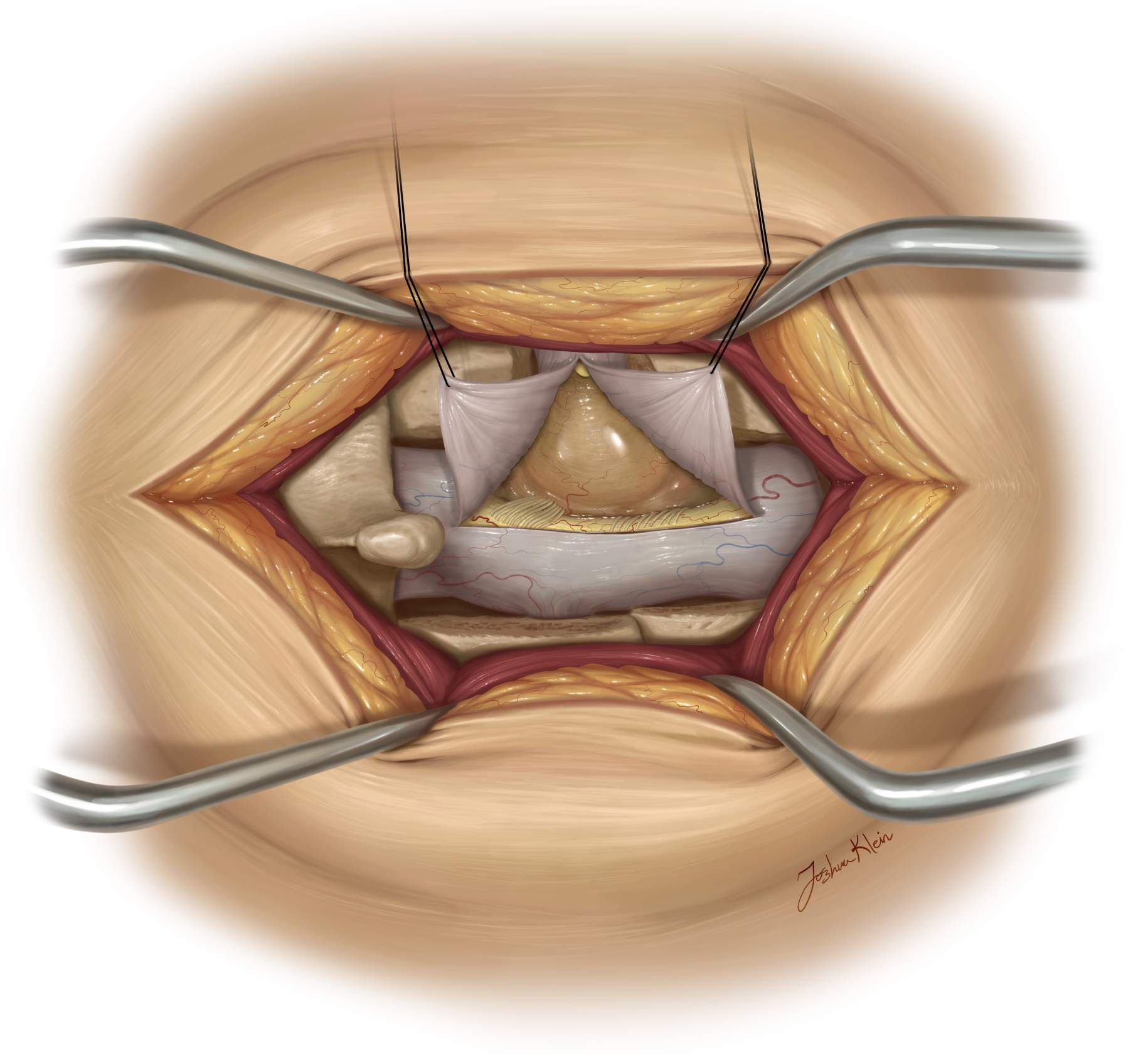Spinal Cord Tumor Treatment


Tumors of the spinal cord are exceptionally rare, accounting for less than 5% of primary tumors of the central nervous system. Treatment can be challenging and risk injuring the spinal cord itself. In this article, we discuss the different treatment options and what each entails.
Types of Spinal Cord Tumors
Spinal cord tumors arising from within the spinal cord tissue itself are called intramedullary spinal cord tumors. The most common types found in this location include the following:
- Astrocytoma: Arising from star-shaped astrocytes. Can range from being non-cancerous (benign) to cancerous (malignant).
- Ependymoma: Arising from ependymal cells lining the central cavity (central canal) of the spinal cord. Can range from being benign to malignant.
- Hemangioblastoma: Arising from cells that form blood vessels. Often benign and associated with von Hippel-Lindau disease.
Other types of spinal cord tumors are located outside of the spinal cord tissue and are referred to as extramedullary spinal cord tumors. These can be further subdivided into those that develop inside or outside of the tough outer membrane surrounding the spinal cord (dura):

Figure 1: This tumor is extramedullary (outside of the spinal cord tissue) and displaces the spinal cord upwards.
Intradural extramedullary spinal cord tumors arise from within the dura, but outside of the spinal cord tissue itself. Common types include:
- Meningioma: Arising from the meninges, the membranes that surround the spinal cord. They are typically benign and more commonly found in women.
- Nerve Sheath Tumors (Schwannomas and Neurofibromas): Arise from the nerve sheath (the covering of nerves) and are generally benign. Schwannomas arise from Schwann cells. Neurofibromas can be part of a genetic condition known as neurofibromatosis type 1 (NF1).
Extradural spinal cord tumors are located outside of the dura. They can involve the surrounding spinal bones (vertebrae) and structures. Common types include:
- Metastatic Tumors: Cancers that have spread to the spine from other parts of the body, such as the lungs, breast, or prostate. This is the most common spinal cord tumor type overall.
- Primary Bone Tumors: These originate from the vertebrae themselves. Examples include osteosarcoma, chondrosarcoma, and Ewing’s sarcoma.
- Lymphomas: Cancers of the lymphatic system that can involve the spinal bones and compress the spinal cord.
Why should you have your surgery with Dr. Cohen?
Dr. Cohen
- 7,500+ specialized surgeries performed by your chosen surgeon
- More personalized care
- Extensive experience = higher success rate and quicker recovery times
Major Health Centers
- No control over choosing the surgeon caring for you
- One-size-fits-all care
- Less specialization
For more reasons, please click here.
Treatment of Spinal Cord Tumors
The treatment of spinal cord tumors depends on many factors. Though generally, options will include surgery, radiation therapy, and in rare cases, chemotherapy.
Corticosteroid medications such as dexamethasone may be used temporarily to help improve neurologic function while waiting for a more definitive treatment such as surgery.
Surgery
The role of surgery in the treatment of spinal cord tumors depends on the exact type of tumor and its aggressiveness. If the tumor is “high-grade”, this means that it is aggressive and tends to spread to other parts of the body. High-grade spinal cord tumors may also be referred to as spinal cord cancer.
For tumors that are high-grade, complete surgical removal may not be the best and safe option. Surgical removal of as much tumor as possible will still not provide a complete cure, as microscopic tumor remnants are likely present. In addition, surgery near the spinal cord presents with risks of permanent neurologic deficits that can be devastating.
In such cases, the surgeon may opt to remove parts of the tumor to alleviate symptoms. Through a partial resection, enough of the tumor is removed to ease its compressive effect on the surrounding spinal cord.

Figure 2: During spinal cord tumor surgery, surgeons carefully cut through layers of skin, bone (spine), and other tissues until they reach the spinal cord and tumor.
Other treatment options such as radiation therapy and/or chemotherapy may also be explored. Thus, treatment of spinal cord cancer is challenging and will require a discussion with multiple health professionals.
If the nature of the tumor is unclear, surgeons will obtain a piece of the tumor during the operation and send it to another physician, a pathologist, to examine the specimen under the microscope. The pathologist will provide a formal diagnosis to help guide treatment planning and prognosis.
In the tumor is benign, or “low-grade”, complete surgical removal can be curative. The goal of surgery is to remove as much tumor as possible while preserving neurologic function. However, if the tumor is intertwined with critical spinal cord structures, some pieces of tumor may be left behind.
Radiation Therapy
Radiation therapy involves the application of multiple high energy beams to the tumor site. This damages the genetic material (DNA) of the tumor, preventing its growth. Radiation therapy is often delivered in either small fractions, or one large dose.
In fractionated radiation therapy, small doses of radiation therapy are delivered daily over several weeks. Each session may last 20 to 30 minutes. This is an outpatient procedure, and patients can go home the same day.
In stereotactic radiosurgery, precise delivery of a high-dose radiation is given in one or a few sessions. These sessions last longer and may take an hour each. Like the fractionated approach, patients can resume their daily activities after the procedure.
Radiation therapy is a helpful treatment, particularly when tumor pieces remain after surgery. In cases where surgery poses too much of a risk, radiation therapy may become the primary treatment modality.
Chemotherapy
Chemotherapy involves the use of medications to treat cancer. It may be recommended in combination with surgery and/or radiation therapy, or when other treatment options have been exhausted.
Chemotherapy is less commonly utilized as a primary treatment for spinal cord tumors because effective drug delivery to the spinal cord can be challenging, and side effects can limit its use. In rare cases, intrathecal agents are used.
In the intrathecal route, the blood-spinal cord barrier is bypassed by direct administration of chemotherapeutic agents into the cerebrospinal fluid via spinal tap (lumbar puncture). The effectiveness of intrathecal chemotherapy and its potential adverse effects is still under investigation.
For primary intramedullary spinal cord tumors, such as high-grade astrocytomas or glioblastomas, the following chemotherapeutic agents have been used:
- Temozolomide (TMZ) – An oral alkylating agent that has been used for high-grade gliomas, including those in the spinal cord. It is often used in conjunction with radiation therapy.
- Bevacizumab – A monoclonal antibody that inhibits vascular endothelial growth factor (VEGF), used to manage tumor-associated edema and as an anti-angiogenic (prevents new blood vessel formation) in recurrent gliomas.
- Cisplatin and carboplatin – Platinum-based chemotherapeutic agents that can be used for various CNS tumors, including spinal cord tumors.
- Etoposide – A topoisomerase II inhibitor that has been used in combination with other agents for the treatment of CNS tumors.
- Ifosfamide – An alkylating agent that may be used in combination regimens for CNS tumors.
For metastatic disease to the spine, chemotherapy is typically part of a systemic treatment regimen based on the primary cancer type. For example:
- Breast cancer metastasis may be treated with agents such as paclitaxel or doxorubicin.
- Lung cancer metastasis may be treated with agents like pemetrexed or docetaxel.
- Prostate cancer metastasis may be treated with hormonal therapies or newer agents like abiraterone or enzalutamide.
Intrathecal chemotherapy, as mentioned previously, involves the administration of chemotherapeutic agents directly into the cerebrospinal fluid. Agents used intrathecally include:
- Methotrexate – A folate antagonist used intrathecally for leptomeningeal metastases.
- Cytarabine (Ara-C) – A pyrimidine analog used intrathecally for meningeal leukemia and lymphoma.
- Thiotepa – An alkylating agent used intrathecally for leptomeningeal disease.
The choice of chemotherapeutic agent depends on the tumor type, molecular profile, and the patient’s overall health and treatment goals. The effectiveness of chemotherapy for spinal cord tumors is variable and often part of a multimodal treatment approach that may include surgery and radiation therapy.
Effectiveness of Treatment
The effectiveness of treatment for a spinal cord tumor varies widely based on the histopathological type of the tumor, its anatomical location within the spinal cord, the extent of disease at the time of diagnosis, overall health status, and the presence of underlying health issues.
Surgical resection remains the cornerstone of treatment for benign spinal cord tumors, particularly for intradural extramedullary tumors such as schwannomas and meningiomas, and for certain intramedullary tumors like ependymomas and hemangioblastomas.
However, its role may be more limited in cases of high-grade tumors. In such cases, radiation therapy and/or chemotherapy may be recommended. The effectiveness of treatment also depends on the competence of the neurosurgeon, as it is their skill that can determine whether resection is maximized in the safest way possible.
It can be overwhelming to consider the many factors that can impact the effectiveness of treatment for your specific case – but that is where your medical team comes in. A diagnosis of a spinal cord tumor will involve a multidisciplinary team to guide you towards a treatment plan that aligns with your goals.
Surgical Recovery
Following surgery, patients will be closely monitored in the intensive care unit (ICU). Neurologic function is frequently assessed to detect any new deficits or changes in status. The medical team will provide pain relief medications to keep your pain under control.
The surgical wound is monitored for any signs of infection, leakage, or blood clot (hematoma) formation. Antibiotics may be administered prophylactically around the time of surgery and may be continued for a short duration after the surgery.
Patients will be encouraged to move around as tolerated to prevent complications such as a blood clot in the leg (deep venous thrombosis) and its subsequent travel to the lungs (pulmonary embolism), and muscle wasting.
Physical therapy and occupational therapy will be critical to the recovery process as it helps to maintain and improve muscle strength, coordination, and functional independence. The rehabilitation program is tailored to individual needs and may include various exercises and activities.
When one can return to normal activities varies widely. Some patients may experience immediate improvement in their neurological symptoms, while others may have persistent or new deficits that require prolonged rehabilitation.
The recovery trajectory can be influenced by the presence of spinal cord swelling, the need for other therapies such as radiation therapy or chemotherapy, and the patient’s overall health and resilience.
In the days, weeks, and even months following surgery for a spinal cord tumor, patients embark on a journey of healing that requires patience and comprehensive care. Incremental progress is normal. Celebrate each small victory, and do not hesitate to rely on family, friends, and support groups during this challenging time.
Key Takeaways
- Spinal cord tumors can be intramedullary, extramedullary intradural, or extradural.
- Treatment can involve surgery, radiation therapy, and in some cases chemotherapy.
- The role of surgery depends on the tumor type and grade, and can be curative in cases of benign tumors such as meningioma and schwannoma.
- Surgical recovery is a process that can take weeks to months, with physical therapy and occupational therapy being critical to regain strength and mobility.











